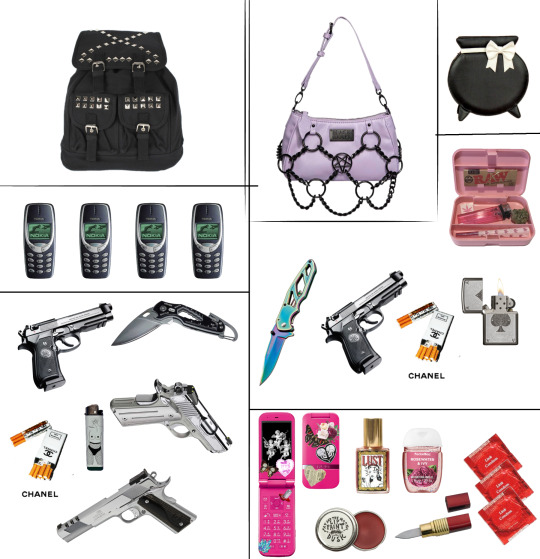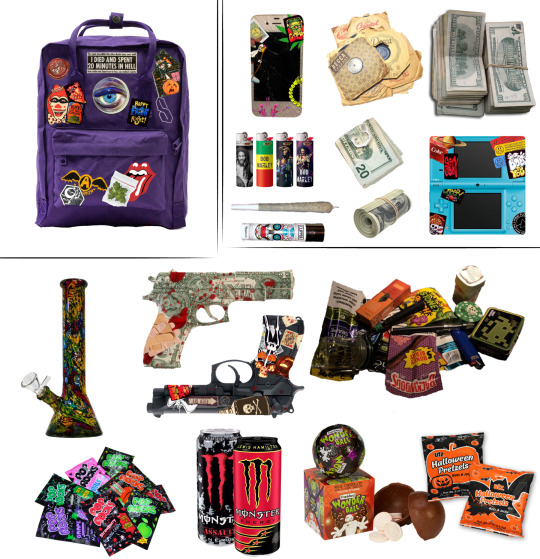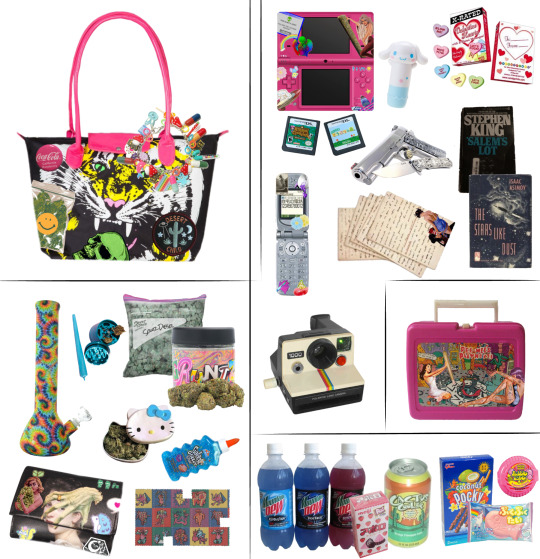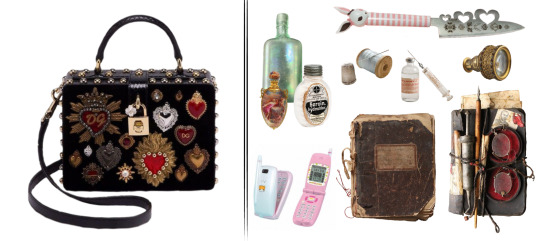#I have literally everything else. all my old sketchbooks. stored in containers
Explore tagged Tumblr posts
Text

so i lost all my art from elementary but I do vaguely remember my neopets faerie oc and decided to draw her c:
DollPalace rainbow tail and all hahah
#neopets#my art#oc#water faerie#still very sad I dont have any of my art from before grade 6#I have literally everything else. all my old sketchbooks. stored in containers#but i do remember using my math set with two half circles and tracing a giant circle for her head and colouring a full rainbow tail hahah
235 notes
·
View notes
Text

(Screencapping the og post cause it's pretty long)
Ok so this is something I've wanted to do with my own old fucks, but I didn't know exactly how I wanted of go about doing it!!! Until my mate @prettyputrified sent in the ask that gave me an idea; polyvores!! So anyway, I made some more "What's in [x character]'s bag" type posts as a response to this!
(Shout-out to @/cuuno for the og concept btw! Png credit will be in reblogs)
(Read tws in tags before proceeding)
-----
Sylvain's Bag

Work Bag: The plain black bag Sylvain takes with him when he goes on jobs. It contains only what he needs, which are usually no more than his weapon of choice and his collection of burner phones. Oh, and a pack of cigarettes. Murder is pretty stressful after all.
Casual Bag: Sylvain's own personal purse and wallet. Despite his rough and violent demeanor, he loves self expression and indulging in the emo/pastel goth aesthetic.
- Pocket 1: Self defense pocket. The streets of Pythonel are a dangerous place, so Sylvain makes sure not to leave the house without a gun and/or knife. The weed is purely for sale by the way, not edglord enough I guess.
- Pocket 2: Self care pocket. Contains his own personal phone, which he decorates in cool stickers he finds while out and about. Also makeup and protection, in case he wants to doll up for someone he fancies.
-----
Aldin's Bag

Shopping Bag: Aldin just uses the same plastic shopping bag he got ten years ago to carry everything. Usually has empty cans and drug garbage in there with everything else. Phone is busted to hell, but you know Aldin's broke ass can't replace it. Get your shit together man what is this???
-----
Jeagar's Bag

Bag: Ann made it (and basically all his clothes) for him. She tries to include stuff she knows Jeagar likes on it. He never says it aloud, but his old ass appreciates it. Always has bugs inside it that he finds in dire circumstances.
- Pocket 1: Used to store weapons and cigarettes. Usually alternates between his collection of fancy weaponry when he goes out. Matchboxes are from Ann's thrift shopping. Never buys any of his cigarettes, instead he digs up used ones from the dump.
- Pocket 2: Leisure pocket. Contains whatever books he's reading at the moment. Carries around his favorite songs on cassette tapes because the radio people have bad taste. Phone is an old ass brick phone he's had for the last 20 years. How does that thing still work??
- Pocket 3: Emergency pocket. Always has at least one Molotov cocktail in his bag. Just in case.
-----
John's Bag

Backpack: Simple brown backpack John brings when he goes on trips. Has his keys and pins that he finds funny. Tomagachi is a gift from Ferris for when he's stressed out.
- Front Pocket: Sketch pocket. Has all his little sketchbooks and pencils for when he's bored. Also draws on pieces of loose paper like receipts and used envelopes.
- Inside (smaller part): Comfort pocket. Has porn and alcohol in it all the time, always. Keeps more hardcore drugs in a vintage tin case. Please don't ask about the wedding ring.
- Inside (larger part): All the random shit he's stolen. Purely does it to satiate his "tendencies", as he calls it. Usually takes valuables or vintage items, but will nab literally anything if need be.
-----
Charles' Bag

Backpack: Old backpack Charles covered in cool stickers and patches. Loves creepy stuff and clutter, which shows in how he decorates most of his belongings. Negative space who?
- Front Pocket: Fun shit pocket. Ready access to drugs, money, music, and most importantly, video games. Phone is some dinky bullshit covered in stickers. Actually has to replace it semi-regularly due to being a temperamental little bitch that destroys shit.
- Main Pocket: "Important" storage pocket. Where he puts his bong when he goes out to a buddy's. Pretty much always has a shitload of random snacks. Always contains at least two guns no matter what.
-----
Ferris' Bag

Handbag: Bag Ferris stole from a thrift store and covered in patches and pins. Decorates the same way Charles does, but has more vintage and kidcore-esc tastes. Oh and also sexy ladies.
- Pocket 1: Storage pocket. Always has drugs on him, either to sell or use. Keeps his wallet in there for business purposes. Mainly has weed, but will also carry other stuff too.
- Pocket 2: Fun pocket. Books and video games for when he's bored. A rough draft of whatever gross fic he's working on in case inspiration strikes him. Weapons used to make potential inspo. A camera to capture said inspo. Phone is nothing special, just a sticker-covered little flip phone he actually takes decent care of.
- Lunchbox: Usually carries this along with his bag. Keeps the bigger snacks and drinks he can't stick in his bag. Organization is important after all!
-----
Daniel's Bag

Handbag: Alternates between one of his many vintage-looking, designer handbags. Loves excessive gold and jewels in his accessories. Minimalism is so overrated. Daniel's cutesy pink and white flip phone is hardly anything special on the surface. Gets a bit strange when you realize it's the only bit of modern tech in Goldberg. Weird...
- Help Pocket: :)
#zop#zombiesofpythonel#polyvore#blorbo posting#collage#ocs#sylvain#aldin#the holders#long post#tw: guns#tw: weapons#tw: drugs#tw: weed#tw: food#minors dni
5 notes
·
View notes
Text
In the first part of my 2018 Resolutions post I encouraged you to draw at least 15-30 minutes a day and as a result of this prompt, I received many requests for suggestions on how to get started. Even if you think you can’t draw, think you don’t know how or just stubbornly refuse, these 5 exercises will help. But before I discuss the How, I would like to discuss the What and Why I feel you must draw everyday.
The What…let’s take the word ‘drawing’ out of this article for now because it tends to scare people. When I’m teaching, I use the words drawing and mark-making interchangeably because for my purposes they are the same thing with only very slight differences. Think of it this way…a mark communicates a word and a drawing expands that word into a sentence…a poem…a sonnet. As artists, whatever we do in the course of making work begins as a mark on a surface made by one human to be interpreted by another in an effort to communicate. Mark making is expressive, gestural, emotive and works of art that contain such marks are the ones I will cross the room to view-they literally speak to me without words, they communicate. No matter what kind of work you make or in what medium, understanding your mark, what it is and how to make it, will make you a better communicator through that work.
The Why…Critic Lance Esplund writes, “Line is a rich metaphor for the artist. It denotes not only boundary, edge or contour, but is an agent for location, energy, and growth. It is literally movement and change – life itself.” This quote speaks to lines specifically, but for the purposes of this article, we’ll think of marks and lines as one in the same. The mark adds the lifeblood to the work that sets it apart from anyone else’s. Your personal mark or gesture is literally as unique as your signature and practicing making marks everyday is the only way to find that mark. As I mention in my Resolutions post, when you practice moving those parts of your body and brain required to make a drawing, everything else in your art making process flows much more smoothly. How many times have you entered the studio cold and stiff from not working and end up puttering around wasting time? Or picked up a paintbrush, but just couldn’t make the paint say what you wanted? The more marks you make and the more frequently you make them, they become indelibly written on your brain, your movements in the studio become more practiced and you will approach the work with confidence and knowing. I’m not saying that drawing everyday will rid you of all the struggles us artists face in the studio, but I absolutely guarantee that it will get you moving faster and in the right direction toward your goals.
The How…Now for the fun part. Your daily drawings can be made with any media on any substrate and inspired by any subject. I like to give myself ‘projects’ in which I work on a series of drawings inspired by one thing with the same media for one month. This offers me a chance to work out every angle of a certain subject and/or experiment with new media. At the end of the month, I also have a series of drawings that may be strong enough to show. Visit this post to read about one of these drawing series’ of mine. You can choose to work with monthly projects or you can draw something different everyday, the point is to make marks daily for 15-30 minutes. For those of you who think you’re too busy to spare this time, I suggest in my resolutions post that you always have a sketchbook and drawing tools with you in your bag because you may have more time than you think…on the bus/train, waiting at the doctors office, waiting in line at the food store. It’s almost depressing how much time we spend waiting so why not do something constructive while you’re at it. Last, don’t forget to set that timer! I’m a stickler about setting the timer for daily exercises like this and I explain a bit about why in this post. In a near future post I’ll talk about restrictions and why they are so important in art making. For now, understand that the timer will create a time-space for you to focus only on what you’re doing. For that short time, you don’t have to think about or do anything else but that draw.
The following drawing ideas are tried and true-a few have been used in art schools for centuries and a few I’ve modified and used over and over in my workshops. Once you start, your creative brain will begin to flow with many of your own ideas. At the end of this article I share some drawings from my workshop participants as well as some other artist’s works whose marks and processes I find inspiring. If you see your drawing below, let me know and I’ll add your name!
The Ideas
Blind Contour Drawings If you went to art school, you probably went blind making blind contour drawings-they are used so much as a learning tool and that is because they are so helpful. Start by staring at an object in front of you for one minute. Then close your eyes and imagine the object in your minds eye…try to see its color, its form, its texture, it’s scale. Then open your eyes and look at the object in front of you. How does it look? Try to spend two minutes (or longer) just looking at the object, examining it in great detail. Then close your eyes and draw it continuously, keeping your eyes closed for a full two minutes. Don’t lift the pencil or open your eyes until your full two minutes are up. If you ‘finish’ drawing your object under two minutes just draw it again. If you find you can’t help yourself from cheating, wear a blindfold. Do this with the same object over and over, or try different objects in order to fill your 15-30 minutes. Another variation is to begin with the blind contour and then with your eyes open, ‘connect’ the sketchy lines you drew to make a new drawing.
Opposites Make drawings in pairs which express opposite adjectives. For example, make a drawing which is noisy in as many ways as possible – your pencil should make a lot of noise as it vigorously scribbles and scratches across the page, and the finished drawing should be noisy in the way in which it communicates. Then take a breath and make a very quiet drawing. Your pencil should hardly touch the paper (imagine it’s the tip of a feather). Hold your pencil far away from the drawing end so you cannot apply too much pressure. Hush your pencil as you draw, and let the end result be a very shy drawing. Enjoy the differences between the two drawings – let your ideas bounce off each other. Push yourself to extremes of noisy and quiet.
Words Choose 5 words randomly from the dictionary and either write them at the top of the page or begin with a drawing of the word itself. I use Design Language by Tim McCreight in my workshops because the words in it lend themselves to visual inspiration. Working on the same paper, spend one-2 minutes interpreting each word with marks. Let each word’s marks intertwine and overlap. Take this drawing a step further and add more marks, collage or stitch to make it a cohesive drawing.
Music This idea comes from one of my favorite artists, Wassily Kandinsky, who believed that colors and marks in paintings created visual ‘chords’ which resonated in the viewer. A must read for any artist is Concerning the Spiritual in Art by Kandinsky in which he writes in depth about the essence of expressionism in painting. Create a playlist of 30 seconds of 20 different songs ranging in tempo, style, genre, etc. Using a large piece of paper on the floor or taped to the wall (must be positioned so that you can use your body expressively) and gather 5 different drawing tools near you so you can switch if you’d like. Turn on your playlist so the songs play successively with only 3-5 seconds between each. Respond to each song with marks and allow the marks to overlap and intertwine. At the end of the playlist, the drawing will likely look like a bunch of scribbles, so what you want to do next is isolate certain areas to use for inspiration. Cut a rectangle out of a piece of paper and float this frame over the drawing. As you do this, you’ll find so many great ideas for marks that you can trace and use in paintings. Another variation is cut up your large drawing and scatter the cut outs onto another large piece of paper. Experiment with with creating new distances between the cut outs, turn them upside down or rip them in half. Begin drawing new elements and shapes in between the old ones to create a new drawing. Forget your original drawing and think about new meanings which might be created, think about how the new drawing might be interpreted.
Response This is my personal favorite method to begin a drawing and I have completed many series this way. ‘Response Drawing’ is a term I coined in one of my workshops and it just stuck. Response drawings are basically just as the words describe… it is a response to marks either you or someone else made intentionally, accidentally or found. Responding to marks that are not yours encourages you to expand your mark making vocabulary by making marks you aren’t normally inclined to make. There are many ways to begin a project like this but the basic premise is to begin with some kind of mark on a substrate-it could be a splash, a pour of paint, a burn, a footprint, rust print, transfer print, a mistake. It could be something you found in the trash, a folded or cut piece of paper, crushed pencil shavings, anything! It could be a project between you and a friend in which one of you makes a mark and the other responds. This actually has a name -Exquisite Corpse- a term and game invented by surrealist creatives. I’ll be writing a more in depth post about Exquisite Corpse, but in the meantime you read about and see some examples of them here. However your first mark is generated, the next step is simply to respond to it in any way you want. The image at the top of this page is from a series of drawings from 2005 called ‘Flesh’ in which I started with tracing paper that had been burned and splashed with watercolor and I then responded with organic forms drawn in graphite and colored pencil. See more from this series in the images below.
If this post was helpful to you, please let me know, I invite your comments questions and suggestions in the comments section now located in the upper left sidebar of this post.
In my next post, I’ll share with you my acrylic/gouache series of layered drawings. I’ll discuss my approach and process for these drawings and how this whole series began by drawing only 15 minutes a day.
OLYMPUS DIGITAL CAMERA
OLYMPUS DIGITAL CAMERA
OLYMPUS DIGITAL CAMERA
OLYMPUS DIGITAL CAMERA
OLYMPUS DIGITAL CAMERA
OLYMPUS DIGITAL CAMERA
Image Links (read left to right from top row)
Workshop student exquisite corpse.
Lorraine Glessner Flesh series response drawing.
Jeri Ledbetter, artist, see her work here and here.
Lorraine Glessner, found ledger sketchbook response drawing.
Workshop student exquisite corpse.
Emma McNally makes drawings responding to unlikely sounds like white noise and city sounds. See her work here.
James Watkinson responds to aged paper and stains of old book covers with detailed narrative drawings. See his work here.
Ayanna Jolivet Mccloud’s experiments with a china marker, making as many different marks as she can. See her work here.
Workshop student music response drawing.
Workshop student scattered elements response drawing.
Workshop student music response drawing.
Workshop student music response drawing. I love how the strong shadows and deep wrinkles of the paper contribute to the drama of this drawing.
Lorraine Glessner Flesh series response drawing.
Workshop student found object mark response drawing.
Workshop student music response drawing.
Workshop student architectural sketch response drawing.
Lorraine Glessner Flesh series response drawing.
Workshop student mixed media drawings collage.
Workshop student mixed media drawings collage.
Workshop student found object mark response drawing.
Workshop student mixed media drawings collage.
Workshop student scattered elements response drawing.
Are you an artist who hates to draw? Making daily marks for 15-30 minutes a day will improve your creative work flow not only in the studio, but in all aspects of your life. These 5 easy exercises will help you get that pencil moving! In the first part of my 2018 Resolutions post I encouraged you to draw at least 15-30 minutes a day and as a result of this prompt, I received many requests for suggestions on how to get started.
#art teaching exercises#art workshops#blind contour drawing#drawing#drawing execises#mark making#mentoring#studio tips
0 notes